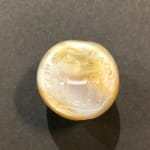Sassanian Seal, 200 BCE - 600 CE
Agate
IL.35
The Sasanian Empire by Guitty Azarpay June 2000 The Sasanian empire (AD 224-642) was the creation of the last great Iranian monarchy before the Arab conquest of Western Asia in...
The Sasanian Empire by Guitty Azarpay June 2000 The Sasanian empire (AD 224-642) was the creation of the last great Iranian monarchy before the Arab conquest of Western Asia in the seventh century. The Sasanians are best remembered for their distinctive cultural expressions and for the longevity of their more than four centuries of rule. The Sasanian age was a dynamic time of cultural and economic revival when a new Persian ruling house in southwestern Iran, like the Achaemenid Persians of a thousand years before, extended its dominion over much of Western and Central Asia, in territories that stretched from Transcaucasia to the Indus. The Sasanian age was also a time of intensified trade and exchange, when Iran served as a major gateway to the transcontinental Silk Road that linked the West with China and the Far East. The Sasanians came into power when Ardashir I, a provincial ruler of Persis, in the Iranian heartland of present-day Fars province, defeated his Parthian overlord, to become the ruler of a new dynasty in Western Asia named after an ancestral figure. By the mid third century, ambitious Sasanian kings extended Persian power across almost 2,000 miles, from the Persian Gulf to the Black Sea, and from Syria's Mediterranean shore to Afghanistan. A principal achievement of the Sasanian dynasty is its replacement of feudal leadership with centralized authority, topped by the king. Sasanian Iran, which remained a highly centralized state for over 400 years, forged a fusion of the offices of church and state, of religious authority and secular rule. As head of state, the dynasty's founder Ardashir (224- 241), a descendant of the Zoroastrian priesthood of Fars, also assumed guardianship of the sacred fire, the symbol of the national religion. This symbol is explicit on Sasanian coins where the reigning monarch, with his crown and regalia of office, appears on the obverse, backed by the sacred fire, the symbol of the national religion, on the coin's reverse. The search for meaning in Sasanian art requires consideration of that art's function, of the ways art is used in Sasanian society. It is the values of the Sasanian elite that inspire Sasanian decorative arts such as engraved gem or sealstone. This widespread and ubiquitous cultural relic was a portable, functional and often highly valued article, produced for special purposes such as the fulfillment of contracts and for commercial exchange. Archaeological evidence of the use of the Sasanian seal is preserved in ancient clay impressions found on documents. Intended as contracts or for the purposes of trade and exchange, documents were tagged with wet lumps of clay impressed with seals as vouchers. The seal was originally attached to strings that once wrapped the letter or perhaps the covered goods. The clay seal impression was to be broken and discarded only at the time of the use of the sealed article.



